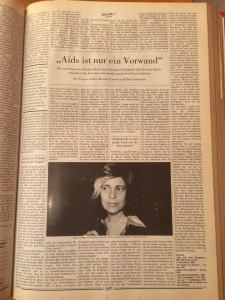Invited speech at the panel on „Communication of Infectious Diseases“ given at the second European Conference of Science Journalists in Budapest on 3 November 2015 at the Hungarian Academy of Sciences. The conference was part of the World Science Forum held in Budapest from 4 to 7 November 2015, hosted by the Hungarian Academy of Sciences in partnership with UNESCO, ICSU, AAAS, TWAS and EASAC.
Infectious Diseases as Metaphor
A quote from The New Yorker, October 7, 2014: “At first there was, understandably, the suspicion that Ebola was the Hitler of apartheid, but now it has become abundantly clear that Ebola is actually the George W. Bush of being forced to listen to someone’s podcast. Folks, this thing is serious. The World Health Organization calls it the Putin of Stalin. In layperson’s terms, that’s like saying it’s the Stalin of U2. Now we are seeing the idea thrown around that it could be the Black Hand of the Black Death, not to mention the Red Peril of the Red Plague. If you don’t want to go that far, you have to at least admit that Ebola is the Al Qaeda in the Islamic Maghreb of Stage IV brain cancer. At this point, it’s very possible that Ebola could become airborne and turn into the Tea Party of extreme climate events.” (Cole, 2014)
Obviously, author Teju Cole in this piece satirizes the use of hyperbolic language in media reports on the Ebola outbreak in West Africa. Even if not taken to the extreme as done by Cole it is fair to assume that most journalists use metaphors to tell the story of the Ebola outbreak.
Now, as a trained journalist – and even as a science journalist – I am not an expert on infectious diseases but rather on metaphors. I therefore request permission to talk about metaphors.
Metaphors have the function of conveying a complex matter into less complex words. It was Susan Sontag who pointed out how metaphors expand their lexical function to acquire a semantic potential reaching far beyond the initial meaning, „giving the thing a name that belongs to something else“ as Sonntag stated, quoting Aristotle (1988, p.5).
26 years ago Susan Sontag was so kind to grant my colleague Monika Czernin and me an interview about her then newly published book “AIDS and Its Metaphors”. The interview took place here in Budapest in June 1989 where Sontag was attending the Wheatland Foundation’s third annual conference on literature. Sontag was extremely kind and endured our unlearned and naïve inquiries of us young journalists with utmost patience turning our rather dull remarks into brilliant questions which she in return answered in a flawless, elegant manner.
At the conference the participating writers including such luminaries as Czesław Miłosz, Adam Michnik, Péter Esterházy, Danilo Kiš and H.C. Artmann discussed the concept of Mitteleuropa, somewhat ridiculed by the summary of the New York Times reporter “as an informal federation of losers, of nations or individuals who have been deprived of autonomy or sense of importance, condemned to live on memories” (Kamm, 1989).
And while at this conference an old Mitteleuropa of intellectuals was laid to rest, outside a seemingly new Central Europe rose from the coffins of history, metaphorically speaking. Just days before the interview with Susan Sontag the re-interment of the coffins of Imre Nagy and four other victims of 1956 had taken place at the Hősök tere in Pest. One of the speakers there had been the young Viktor Orbán who at this occasion accomplished to seize the ceremony by assigning a sixth coffin symbolizing all unnamed victims to his own agenda: “Indeed then, in 1956, did the Hungarian Socialist Workers’ Party rob us—the young of today—of our future. Therefore in the sixth coffin lies not only a murdered young man but also our next twenty, or who knows how many, years.“ (Orbán, in Ittzés, 2005, p.9)
Obviously, Sontag and we had no idea that we had missed a true master of the metaphor in the making.
Now, in “Illness as Metaphor” published in 1978 Sontag stated that (according to the reviewer Denis Donoghue) “metaphors are lurid (and) turn each disease into a mythology” (Donoghue, 1978). In the case of a cancer patient the according stereotypes might sound like this: “someone emotionally inert, a loser, slow, bourgeois, someone who has steadily repressed his natural feelings, especially of rage. Such a person is thought to be cancer-prone.” (ibid.) Elaborating on this topos in “AIDS and Its Metaphors” eleven years later Sontag expanded the impact of metaphors from the individual patient to subgroups of society like – initially – homosexual men and intravenous drug users. According to Sontag the metaphors that we associate with disease contribute not only to the stigmatization of the disease, but also to the “stigmatizing of the ill.” (1989, p. 94)
Sontag states that the most honest approach for regarding illness is the one “most purified of, most resistant to metaphoric thinking”. (1978, p.3.) A disease should be regarded as a disease, not as a sign of some terrible law of nature or an otherwise unnameable evil: „(O)ur views about cancer, and the metaphors we have imposed on it, are so much a vehicle for the large insufficiencies of this culture, for our shallow attitude toward death, for our anxieties about feeling, for our reckless improvident responses to our real ‘problems of growth’, for our inability to construct an advanced industrial society which properly regulates consumption, and for our justified fears of the increasingly violent course of history.“ (ibid., p.87-8)
What Sontag tells us here is that metaphors are distractions from the real problems, that they are used to camouflage the true challenges and that they are deliberately applied to fog our perceptions and our conclusions. This enables metaphors to allude to archetypical images that evoke basic emotions like anger and fear. The recent past has reminded us that this impact of metaphors is not restricted to disease. As the world seems to increase in complexity – often expressed in an intangible, virtual manner – metaphors related to physicality thrive.
To prove this point I quote the Hungarian scholar Anna Szilágyi. By using speeches from the election campaign of Viktor Orbán for the Hungarian parliament in 2010 for a discourse analysis in the tradition of Wodak et al Szilagyi discerns a “metaphorical representation of the country”. She continues: “Both Hungary and its economy were presented (…) in the form of a metonymy: the country and the Hungarian finance system appeared in the texts as human beings, who engage in physical activities, share corporal attributes, and even have a physical body. The country and the economy were presented as weak and ill beings who seek accordingly physical treatment or support.” (2010, p.48)
Turning to the current events: to deny refugees the “fundamental right to a better life” (Orbán, in N.N., 2015, 1) is not an exception from the rule of metaphor but an inherently logical extension of the rule of metaphor as the speaker with this expression assumes the position of a divine power judging the living and the dead. And comparing refugees to “warriors” (Orbán, in N.N., 2015, 2) can be related to Sontag’s observation that “disease is seen as an invasion of alien organisms, to which the body responds by its own military operations, such as the mobilizing of immunological ‘defenses’“. (1989, p.9)
The role of journalists in this situation? A voice of reason, not a scream of excitement. A comprehension of scholarly thinking and its closest possible translation into lay terms walking the thin line between inherent complexity and inappropriate simplification. The ability to detect deeply ingrained concepts like the obsession with the ultimate antithesis of life and death as illustrated by the sixth coffin and the divine judge. Time to analyse the problem and the courage to retract in case of error. With the words of the great Harry Rowohlt: “Say, what you think. After actually having grasped a thought.” (1992) Summarized in a (metaphorical) nutshell: mistrust the metaphors.
What Sontag, Szilágyi and others tell us is to interpret metaphors as harbingers of delusion, as markers of misconception, as indicators of intellectual dishonesty and moral treachery. In short: metaphors can become infectious diseases themselves, spreading a virus of deceit and exaggeration, of abuse of power, of destruction of common sense and civic virtues.
I am ending on a grim note, I am afraid: any assumption that every metaphor will be detected and thus avoided is, of course, delusional. At the end of the interview in 1989 I asked Susan Sontag whether she expected that AIDS might be cured one day. Her answer: „We won’t be able to cure it, but we will be able to handle it“. (Sontag, in Czernin and Lehmann, 1989) Shifted to the topic of metaphors this might be the best we can hope for.
Bibliography
Cole, T. (2014) “What is Ebola” in The New Yorker , 7 October 2014 [online] http://www.newyorker.com/books/page-turner/what-is-ebola (Accessed 28 October 2015)
Czernin, M. and Lehmann, O. (1989) “Aids ist nur ein Vorwand” in Falter, 26/1989 [online] http://www.oliverlehmann.at/wp-content/uploads/2015/10/IMG_51701.jpg (Accessed 28 October 2015)
Donoghue, D. (1978) “Illness as Metaphor” in New York Times, 16 July 1978 [online] http://www.nytimes.com/1978/07/16/books/booksspecial/sontag-illness.html?_r=0 (Accessed 28 October 2015)
Ittzés, G. (2005) „Ritual and National Self-Interpretation: The Nagy Imre Funeral“ in Religion and Society in Central and Eastern Europe, Volume I, Zagreb, Institute for Social Research [online] http://www.rascee.net/index.php/rascee/article/view/26/7 (Accessed 28 October 2015)
Kamm, H. (1989) “Writers, Meeting in Budapest, Warm to a Concept” in New York Times, 22 June 1989 [online] http://www.nytimes.com/1989/06/22/books/writers-meeting-in-budapest-warm-to-a-concept.html (Accessed 28 October 2015)
N.N. (2015, 1) „Es gibt kein Grundrecht auf ein besseres Leben“ in Frankfurter Allgemeine Zeitung, 12 September 2015 [online] http://www.faz.net/aktuell/politik/fluechtlingskrise/kritik-aus-ungarn-es-gibt-kein-grundrecht-auf-ein-besseres-leben-13798797.html?printPagedArticle=true#pageIndex_2 (Accessed 28 October 2015)
N.N. (2015, 2) “Für Orbán sehen die ‘Flüchtlinge wie Krieger’ aus“ in Die Welt, 2 October 2015 [online] http://www.welt.de/politik/ausland/article147130003/Fuer-Orban-sehen-die-Fluechtlinge-wie-Krieger-aus.html (Accessed 28 October 2015)
Rowohlt, H. (1992) “Fragebogen” in F.A.Z. Magazin, Mai 1992 [online] http://dynamic.faz.net/red/fragebogen/fragebogen_harry-rowohlt.pdf (Accessed 28 October 2015)
Sontag, S. (1978) “Illness as Metaphor” New York, Farrar, Straus & Giroux
Sontag, S. (1989) “AIDS and Its Metaphors”, London, Allen Lane
Szilágyi, A. (2010) “The political language and the human body: comparative discursive analysis of Vladimir Putin’s 2000 and Viktor Orbán’s 2010 campaign rhetorics” Budapest, Central European University [online] http://www.etd.ceu.hu/2010/szilagyi_anna.pdf (Accessed 28 October 2015)

